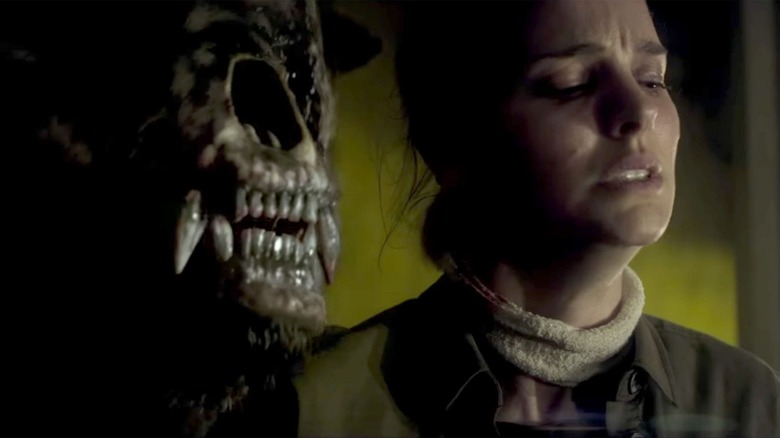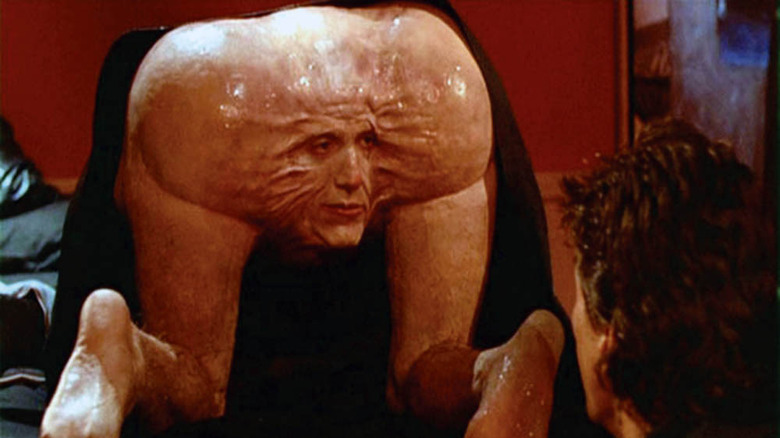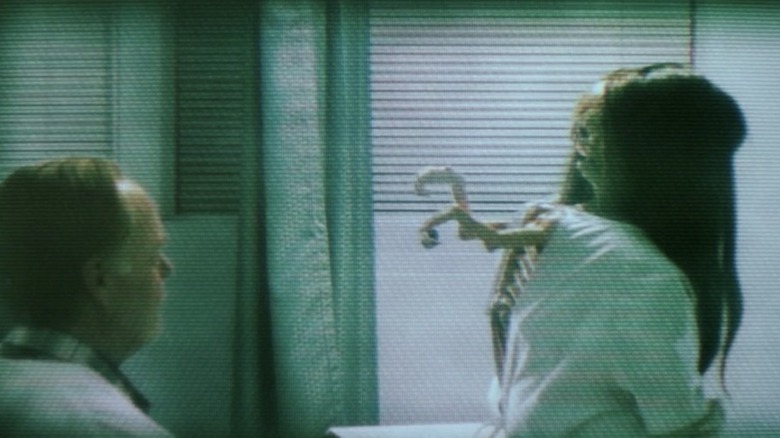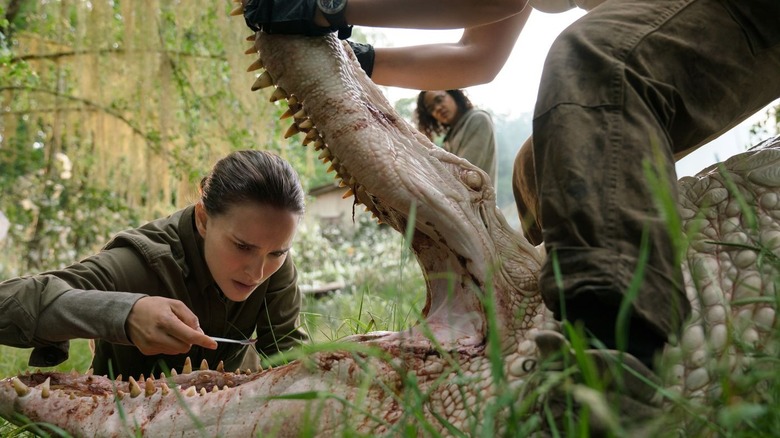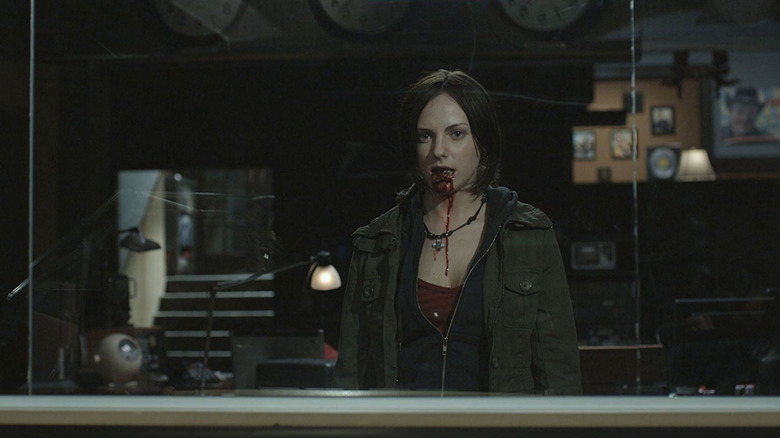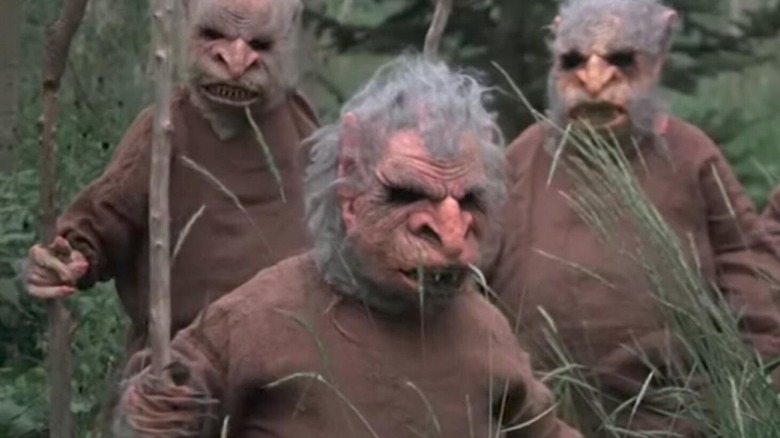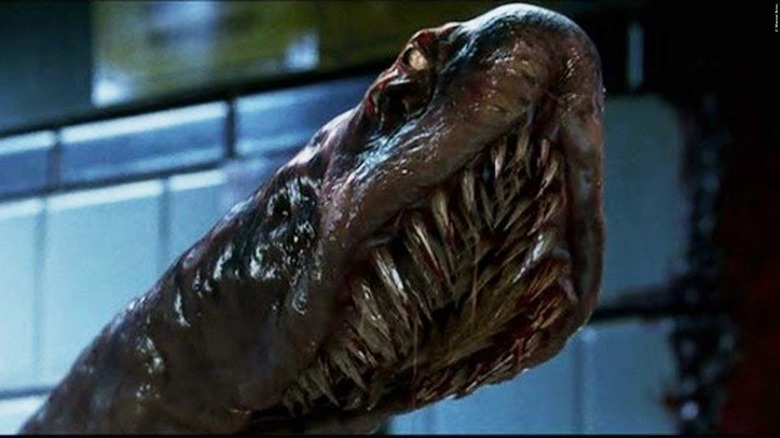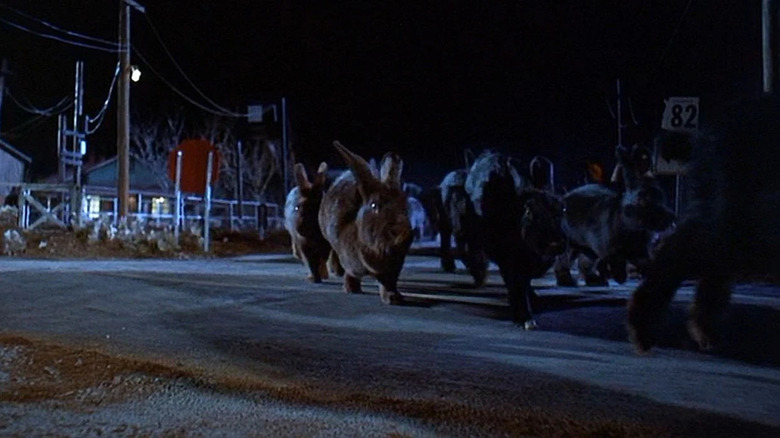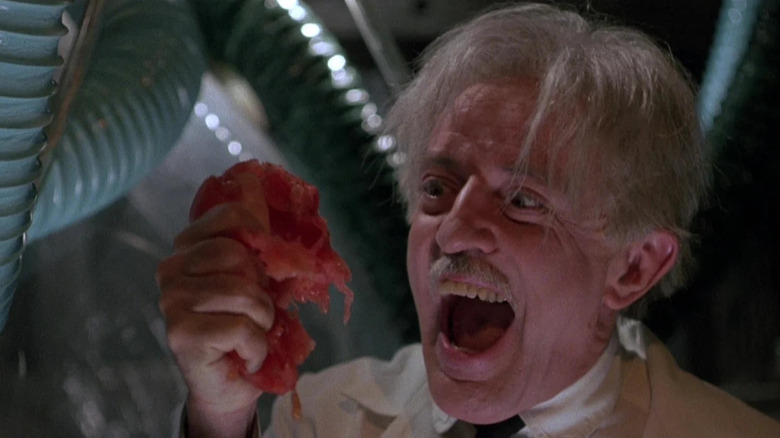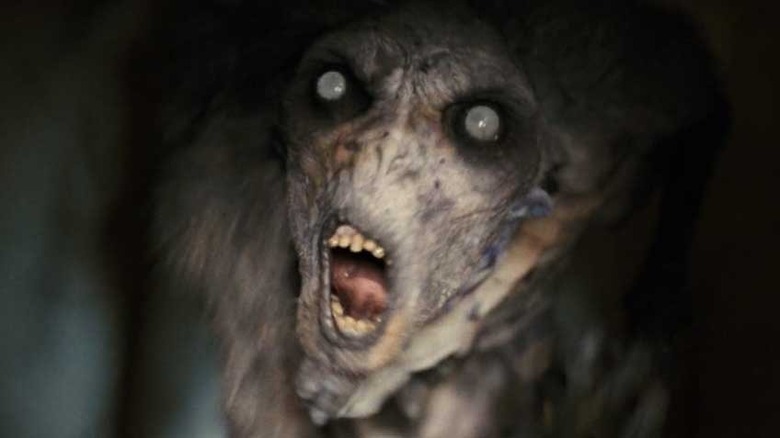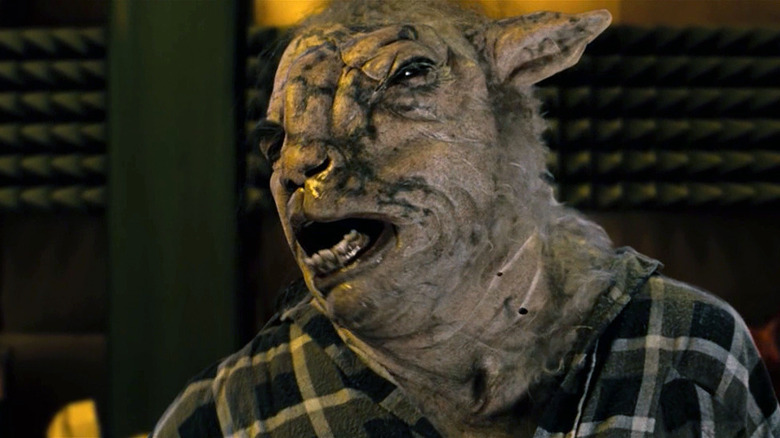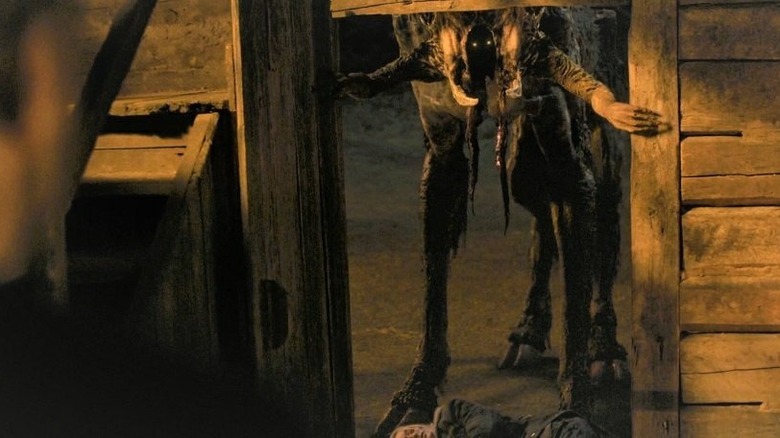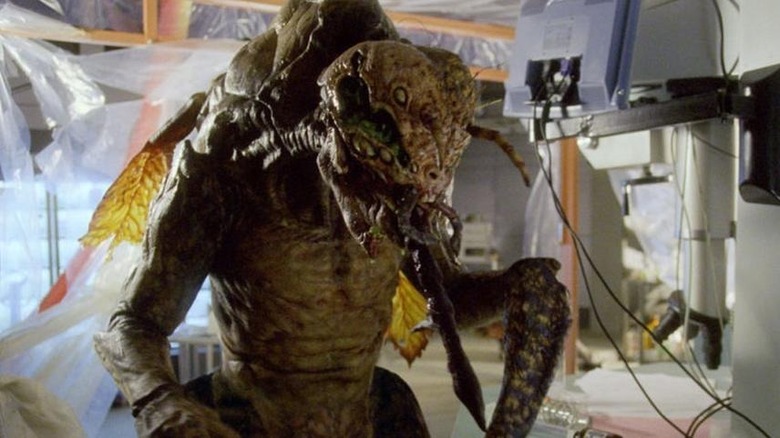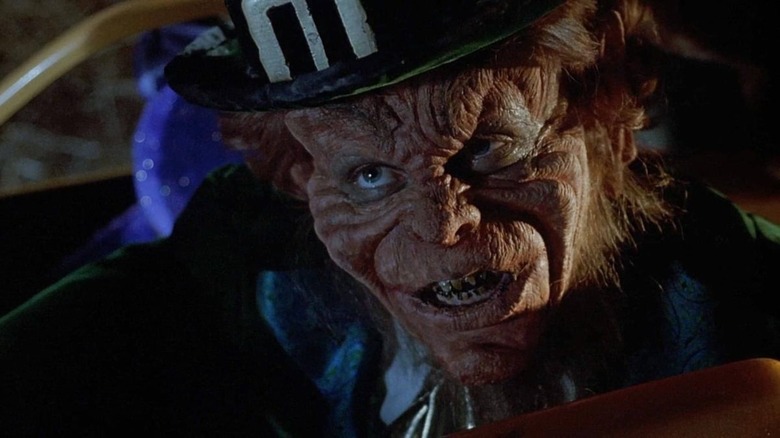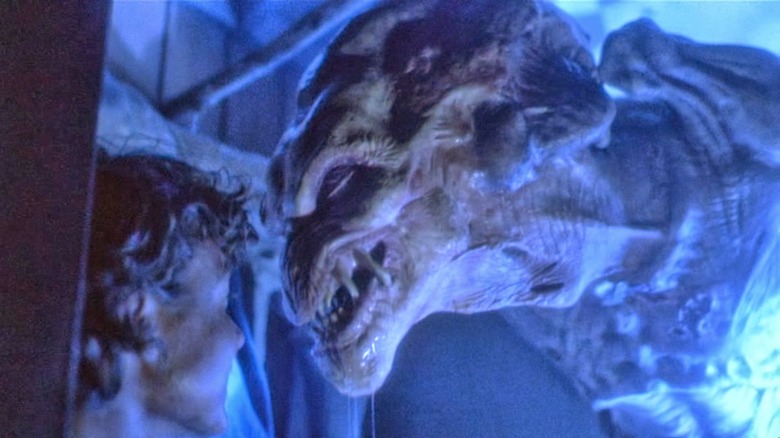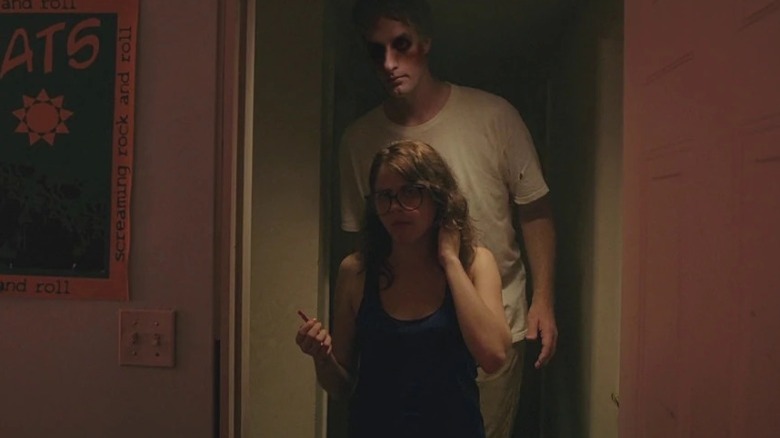Horror Movies With Unconventional Monsters
When most people imagine a movie monster, they probably think of one of horror's iconic creatures: a zombie lurching in a graveyard, a vampire hunting its prey, a werewolf transforming in the moonlight. But even the classics occasionally get old. Over the years, horror films have become more adventurous with their premises, expanding the concept of what a "monster" is and can be in cinema.
Maybe the monster is a masked human being with homicidal impulses. Sometimes monsters are personifications of concepts — like grief, rage, or the fear of losing touch with reality. Evil gingerbread cookies, a rampaging tire, or a carnivorous bed can appear on the screen. There have been some weird horror movie monsters. Lately, filmmakers seem ready to shock and surprise audiences by subverting our expectations. Grab your popcorn, be wary of incoming spoilers, and get ready to be appalled, delighted, and terrified. Here are some of the most unconventional monsters in horror movie history.
The Socialites (Society)
Sometimes it can seem like America's ultra-rich citizens, the one-percenters, are a completely different species from the rest of us. But what if they actually were? Wealth, privilege, and class disparity are the evils at the heart of Brian Yuzna's 1989 film "Society." Bill (Billy Warlock), a young man from a wealthy family begins to suspect that his parents (and the rest of their hoity-toity friends) are a part of something darkly twisted. He theorizes that they're a part of a murderous cult. However, the truth is much stranger and even more disgusting than he could imagine.
It turns out that Bill's family, and the rest of their "society" friends, are not human at all. Instead, they belong to a race of shapeshifting creatures capable of melding into one another in a practice they call "shunting." They also have a taste for cruelty, conspiracy, and death. "Society" takes the metaphorical evils of wealth inequality and classism and transforms them into a nauseating mass of goo and flesh.
Gabriel (Malignant)
"Basket Case" gave us Belial, a twisted and homicidal conjoined twin seeking revenge after an unwanted separation. Evil twins are nothing new, but James Wan's "Malignant" takes the concept to new, bizarre heights with Gabriel (Marina Mazepa), the film's killer. At first, Madison (Annabelle Wallis) believes he's her long-forgotten imaginary friend. Slowly, Gabriel reveals himself to be a part of Madison, one she never actually lost. When doctors failed to separate Gabriel from Madison's spine and brain, they pushed his remaining brain tissue into her skull and stitched her up. His dormant consciousness has been waiting to reemerge.
After Madison sustains a traumatic head injury at the hands of her abusive husband, Gabriel wakes up. He starts coming out to play, emerging from the back of Madison's head with a warped face and malicious intent. It's a wild concept, but the film's execution is what makes Gabriel something special. When the audience sees Gabriel in action, piloting his host body in reverse, almost none of it is CGI. According to "Malignant" executive producer Ingrid Bisu, Gabriel's backward movement was brought to life for real, thanks to the physical work of Mazepa. Love or hate him, Gabriel is a movie monster audiences aren't likely to forget soon.
If you or someone you know is dealing with domestic abuse, you can call the National Domestic Violence Hotline at 1−800−799−7233. You can also find more information, resources, and support at their website.
The Bear (Annihilation)
When it comes to science fiction horror, "Annihilation" is in a league of its own. Director Alex Garland wanted to embody the atmosphere of Jeff VanderMeer's novel. Garland worked hard to capture its dreamlike uneasiness on film. He succeeded and filled the movie with beautiful, uneasy visuals that transport the viewer into The Shimmer, an incomprehensible world as mesmerizing as it is deadly. In The Shimmer, life does not play by the rules we understand. There are enough unique creatures in the film for a list of its own, but one monster, in particular, really stands out: the Bear.
Calling the creature a bear is a bit of an understatement: This mutated predator is responsible for the Annihilation's biggest scare. Lena (Natalie Portman), Dr. Ventress (Jennifer Jason Leigh), and Josie (Tessa Thompson) wake up tied to chairs by Anya (Gina Rodriguez). They then hear a scream from the group's first fallen member. But it's not her screaming: it's The Shimmer's warped take on a bear, merged with their dead friend, blood dripping from its jaws. A mixture of a recognizable threat and something stomach-churningly alien, the Bear earns itself a place in many horror fans' nightmares, as it perfectly exemplifies the unprecedented dangers lurking in The Shimmer.
Language zombies (Pontypool)
Zombies often make for compelling movie monsters. However, whether they're shuffling corpses or vicious victims of a rage virus, these monsters aren't exactly unique. In fact, at times, it seems like every take on the zombie mythos has been explored. But occasionally, a film comes along that reimagines a zombie outbreak like none before it. Even though the infected in "Pontypool" aren't technically zombies, as none of them are dead, the film is a fresh take on the zombie subgenre.
In Pontypool, a small Canadian town, a radio announcer finds himself in the middle of a bizarre outbreak. Ordinary people are turning violent and attacking each other. Like in many zombie films, these people have succumbed to a strange virus. But this one spreads through words. The monster is language, the carrier for a new kind of sickness that spreads without droplets and touch. It's all about the words the characters say and hear. There is no quarantine, no vaccine, and no escape. "Pontypool" gives a new meaning to the adage "speak no evil."
The Goblins (Troll 2)
"Troll 2" may not exactly be a good movie by any standard. However, it's left an indelible mark on pop culture history that spawned a cult fanbase, midnight screenings, and a documentary directed by Michael Stephenson, the film's former child star. "Troll 2" is known for its over-the-top performances, endlessly quotable dialogue ("They're eating her! And then they're going to eat me! Oh my GOOOOOOOOOOOD!"), and ridiculous practical effects. But one piece of the "Troll 2" puzzle that rarely gets enough love is its main villains. No, they're not trolls. There aren't any trolls in "Troll 2," actually.
They're goblins, the residents of Nilbog — a race of evil, shapeshifting vegetarians. The goblins lure unsuspecting humans to their town, feed them enchanted food, and turn them into human-plant hybrid piles of bright green goo. Also, they get all their power from a magic rock taken from Stonehenge. They think coffee is "the devil's drink," and they have a violent hatred of meat. While they don't make much sense, one thing is for sure: you've never seen anything like them before.
Ripley (Dreamcatcher)
Adapted from the Stephen King novel of the same name, "Dreamcatcher" features one of the weirdest, wildest, and grossest takes on aliens. The creatures come in two forms: the adults, which resemble snake-like monsters with legs, and the babies, which are legless and more closely resemble worms. Since the younger aliens develop inside of a host organism's stomach, then escape by eating their body from the inside and leaving through the posterior region, the aliens are also called "s***-weasels."
Of course, a parasitic alien bursting out of a human host is nothing new. We've seen that before in "Alien." But "Dreamcatcher" references this by nicknaming its aliens "Ripley," after Sigourney Weaver's character. However, these aliens have another ability: telepathy. Not only that, but they can give telepathic skills to those around them. Oh, and they're not just animals. They're also a virus, capable of spreading their infection by bursting into a cloud of red dust filled with viral mold spores. As King's General Kurtz character says in the book, "they're one tough mother to beat, just like that 'Alien' chick."
Bunnies (Night of the Lepus)
If most people closed their eyes and imagined the least dangerous animal in the world, they'd probably think of bunnies. Those little, fluffy, floppy-eared guys couldn't harm a soul. Even when they're mercilessly tearing into some fresh vegetables, it's adorable. Sure, "Monty Python and the Holy Grail" featured one killer rabbit but played it for laughs. No earnest horror film would ever try to make rabbits scary.
Wrong! 1972's "Night of the Lepus," based on the novel "The Year of the Angry Rabbit" by Russell Braddon, did just that. The film sees an all-star cast, including Janet Leigh and Stuart Whitman, facing off against giant, aggressive rabbits. The beasts were brought to life on film through movie magic, using a combination of actors in rabbit suits and shots of regular-sized rabbits rampaging through miniature model sets. While the filmmakers were going for screams of terror, they got more laughs than anything else. Still, they swung for the fences with this one. You have to admire the effort.
Tomatoes (Attack of the Killer Tomatoes)
Man vs. nature is a time-honored conflict, often explored throughout the world of storytelling. Sometimes humanity faces off against the harsh, unfeeling wild like Leonardo DiCaprio's Hugh Glass did in "The Revenant." Sometimes we're punished for daring to meddle in the natural world like Jeff Goldblum's ill-fated scientist in "The Fly." Protagonists have gone up against animals, natural disasters, and the challenge of survival again and again. But what about a different kind of natural antagonist? What about the underexplored conflict of man vs. vegetable (technically man vs. fruits)?
Admittedly, it's a bit of a stretch to call "Attack of the Killer Tomatoes" a horror film. But the film's original poster described it as a "new musical comedy horror show," so it's earned itself a place on this list. "Attack of the Killer Tomatoes" opens with an overt reference to Alfred Hitchcock's "The Birds," visually drawing a comparison between the avian antagonists of the 1963 film and rotten tomatoes that wreak havoc on humanity. But this movie is unlike any other. Murder scenes have tomato juice trails. Tomatoes attack swimmers from beneath the surface of the water. While it's not necessarily a good movie, it is the only one where a talking carrot celebrates the defeat of a tomato army.
Tooth Fairies (Don't Be Afraid of the Dark)
Guillermo del Toro is a master of monsters, whether they're a romantic lead like the fish man in "The Shape of Water" or a child-eating nightmare like the infamous Pale Man in "Pan's Labyrinth." But an underrated Guillermo del Toro monster, from an underrated film he produced, whispers from the darkness of the basement in 2010's "Don't Be Afraid of the Dark." These are the homunculi, a race of ancient, shadow-dwelling beings that feed on children's bones, especially teeth.
Sometimes these teeth are freely given. The homunculi accept offerings from children in exchange for pieces of silver left underneath their pillows while they sleep. However, Tooth Fairies can't be trusted to peacefully uphold their end of the bargain. They are vengeful, incredibly hostile, and above all else, hungry. The homunculi are repelled by bright lights and temporarily trapped if their lair's entrance is blocked. But they have no problem waiting for prey to stumble into their domain. Tooth fairies have "all the time in the world."
The Sheep (Black Sheep)
Little known fact: whenever someone says "wake up, sheeple!" they're referencing the terrible half-sheep half-human abominations in the 2006 New Zealand film "Black Sheep." Don't Google it: it's true. The film takes some of the most non-threatening animals, a species of creatures considered so docile that a wolf would wear its clothing to appear harmless, and turns them into killers. The result is a horror comedy that's hysterical and grotesque in equal measure.
The sheep in "Black Sheep" are no ordinary barnyard animals. They've been genetically altered and turned from fluffy herbivores to aggressive predators with a voracious appetite for human flesh. Anyone bitten by one of these mutant sheep will become infected and doomed to transform into a half-human-half-sheep — a weresheep, if you will. Man-eating sheep may not sound like the most terrifying foes to face. Sometimes, they're really not. But as much as "Black Sheep" is silly, it also manages to elicit some moments of genuine disgust, shock, and fear.
Jötunn (The Ritual)
If you're out in the wilderness, and the forest goes quiet, with no sounds of insects, birds, or animals, that's a warning that the wildlife knows something you don't. Something dangerous has come to that forest. When the protagonists of "The Ritual" hike through the Kungsleden in Northern Sweden, they encounter an eerie silence, ritualistically murdered animals and humans, and an impossibly powerful, malicious creature from Norse mythology. Monsters from Norse folklore have appeared in several horror films, from "Trollhunter" to "Valley of Shadows," but "The Ritual" sets itself apart from them with its Jötunn.
Known as one of the bastard children of the trickster god Loki, Jötunn stalks travelers that wander through its forest, selecting those who have experienced emotional pain as potential devotees. Then, individuals must choose between supplication or death. As one of the creature's devoted worshippers says, "You will kneel before the god. If not, it will hang you from the trees." From the creature's behavior pattern and dedicated cultists, to its horrifying appearance — including glowing yellow eyes seemingly peering out from the darkness of a human stomach — the Jötunn cements "The Ritual" as a standout piece of folk horror.
Mansquito (Mansquito)
Bet you can't guess what this thing is. Just kidding, the being is exactly what the name implies: part man, part mosquito. This SyFy original film takes inspiration from Cronenberg's "The Fly," but it ratchets things up a notch with a little bit of extra bloodsucking terror. Convict Ray Erikson (Matt Jordan) is the test subject for an experimental virus cure. Since this is a sci-fi horror movie, something goes horribly wrong. An explosion covers him with chemicals and genetically altered infected mosquitos. Soon after, he begins to transform into the Mansquito, an enormous mosquito creature with wings, an exoskeleton, and a long proboscis perfect for draining the blood of its victims.
The Mansquito can fly, climb walls, and has superhuman strength. Unfortunately for the monster, and fortunately for humanity, it's no match for electrocution. The Mansquito may resemble other iconic monsters of horror movies past (hello, Brundlefly), but its use of one of nature's most irritating bloodsuckers (and transmitter for several deadly real-life viruses) makes for a fun, disgusting twist on the human-insect subgenre of horror.
The Leprechaun (Leprechaun)
Irish folklore can be a rich playground for horror storytelling. Traditional fairy stories are less "clap your hands if you believe" and more "stealing children in the dead of night and horses dragging people to their deaths at the bottom of a river." Films like "The Hole in the Ground" and "The Hallow" have borrowed from these darker Irish fairytales to scary success. But only one horror franchise has been brave enough to embrace a folkloric figure that almost no one would consider frightening. Most people associate magical little men in green hats with a marshmallow cereal brand, but the "Leprechaun" films do their best to turn the gold-guarding fairies into slasher villains.
In "Leprechaun," the titular supernatural creature is less into clover-shaped marshmallows and more into seeking bloody revenge on anyone who steals his gold. The first film sees Leprechaun (Warwick Davis) facing off against Tory (Jennifer Aniston). Subsequent films in the franchise follow the Leprechaun all over the place — from Los Angeles to outer space. Davis' performance as the Leprechaun brings some desperately needed humor to an absurd premise and carries the franchise to maliciously fun heights. These films won't haunt your nightmares, but they know what story they're telling. He's a murderous leprechaun who wants his gold back and will do anything to get it. What more do you need?
Pumpkinhead (Pumpkinhead)
Demons are a dime-a-dozen in horror. Throughout the genre, demons possess children, appear behind people in mirrors, and influence humans to commit evil acts. But there are no demons quite like the titular demon of "Pumpkinhead." Pumpkinhead is a revenge demon summoned by those who desire vengeance. Once it's called, Pumpkinhead follows that singular purpose, working its way through the intended victims and leaving others alone — unless they try to stop it. Deeply sadistic, the creature enjoys the violent acts it carries out. For horror, a lot of this is a par-for-the-course tale about a demon bound to humans by a dark summoning ritual.
What sets Pumpkinhead apart from other horror movie demons, aside from its iconic creature design, is the strange, symbiotic relationship between it and its summoner. In the first "Pumpkinhead" film, protagonist Ed (Lance Henriksen) notices that he and the creature are becoming one. When Pumpkinhead is hurt, it hurts Ed in return. As Pumpkinhead takes on a more humanoid appearance, Ed becomes more monstrous. The only way for Ed to destroy the monster is to destroy himself. It's an unsubtle but effective exploration of revenge's corrosive and destructive nature. There's no way to seek vengeance without becoming forever changed, as there's no way to deal with a demon without eventually becoming one.
The Entity (It Follows)
Sometimes the scariest threat is one that can hide in plain sight. Few horror movie monsters are as adept at blending into a crowd as the entity from "It Follows." Able to look like anyone, from a familiar friend to an innocent old woman, the entity is only ever doing one thing: walking straight for you. The effectiveness of the entity lies in its simplicity. There is no complex lore, no secret weakness, and no sharp fangs. It looks like a person, but it isn't one. It follows you until you get too exhausted to run anymore. Then, it kills you.
The nature of the entity borrows from a few well-worn horror archetypes. Like classic slow-walking zombies, it doesn't need to rest. Eventually, its inhuman endurance lets it win out over human speed and desperation. It is the proverbial tortoise, and its victims are the hare. Like other shapeshifters, it can use whatever form it wants to appear innocent, allowing the monster to escape detection until it's too late. Like Sadako in "The Ring," the only way to escape death at the entity's hands is to pass the curse to someone else. Although this monster stands on the backs of films that came before it, "It Follows" contains a unique, and frightening monster.
